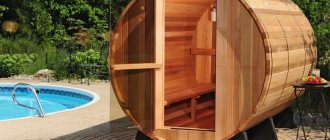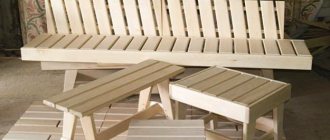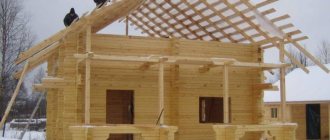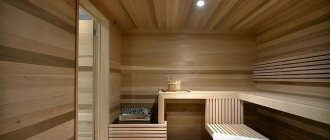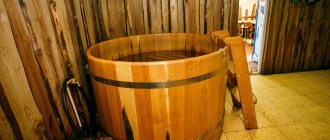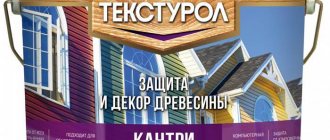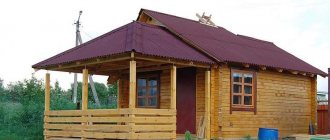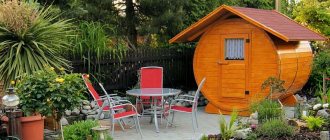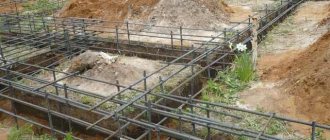Recently, Russia has seen an increase in the pace of construction of private residential buildings.
As a rule, such structures are erected on land plots together with bathhouses, without which Russians cannot imagine a proper vacation, and the production of bathhouses in such places is an excellent business idea.
You can organize a good business in the construction of barrel-type baths.
In this market segment there is a tendency towards the construction of small structures (barrel baths).
They are round wooden frames made from planed boards.
The retail cost of such structures is low (from 90 thousand rubles). That is why there is a stable demand for barrel baths.
Design Features
The main feature of a barrel sauna is its barrel-shaped or cylindrical shape. Two round end panels with a diameter of 2.5-3 meters are sheathed with boards, forming a cylindrical body. The boards are tied together with bandage tape. Minimal contact with the ground provides good thermal insulation. Inside the barrel, a floor is laid, benches, a sauna stove, and, if necessary, partitions are installed.
The light summer cottage option is limited to this; 1-2 people can steam in a 2-meter barrel with minimal amenities. More advanced structures up to 12 meters long are connected to electricity, water supply and drainage, have a steam room, soap bar, shower, forced ventilation and a relaxation area. They can accommodate up to 5-6 people.
The doors in the partitions are made of wood; in expensive models, they are made of tinted or frosted glass. Sometimes, instead of a small window in the end panel, it is made entirely or completely from tempered glass or double glazing.
Barrel baths also include miniature single-seat baths made from a half-barrel standing vertically. Ofuro, or Japanese heated bath, is gaining popularity outside of its native country.
What is included
The sauna barrel is supplied as a complete kit for assembly. From different manufacturers, some elements may be pre-assembled.
Turnkey barrel bathhouse in the form of a set of parts
The kit contains everything you need for assembly:
- High quality Nordic spruce board.
- Metal tightening straps (hoops) that firmly hold the structure.
- Two or three stable supports.
- Front door.
- Lining made of linden, alder or aspen for finishing the steam room.
- Two seats outside under a canopy.
- Ventilation grates.
- Soft roof.
- Oven with stones.
- Fastening elements.
Such a barrel sauna is inexpensive for the buyer.
Types and sizes
In such a bathhouse you can equip the following types of health procedures:
- Traditional Russian steam room with washing area. The steam room is filled with wet steam at temperatures up to 85°C. It gives special pleasure to whip yourself or a friend with a birch or oak broom. After the steam room, be sure to splash yourself with a bucket of cold water in the washing area. Such a bathhouse consumes a lot of water; you should consider a way to drain it into the drainage.
- Finnish sauna. Dry and very hot steam is used here - up to 120°C. It is necessary to consider a ventilation and thermal insulation system in order to quickly warm the room to the required high temperature. If space allows, then install a font for dipping. Otherwise, they will equip a dousing font - a bucket of water suspended from the ceiling.
- Ofuro. Single heated mini-sauna from Japan. The half-barrel is placed vertically, a seat and a water heating system are installed in it. Ofuro is often placed outdoors, in which case the barrel is closed on top with a lid with a cutout for the head.
Japanese bathhouse Ofuro
The size of the structure determines its capacity and the ability to accommodate additional amenities and premises. The steam room itself occupies 2 m, and this is the length of the minimum module.
- Mini - from 2 to 2.5 m, 2 (lying on shelves) to 4 (sitting) people of average build fit into the steam room. Such a bathhouse weighs up to half a ton.
- Standard - up to 3.5 meters long. In addition to the steam room, there is a modest dressing room that helps place clothes and keep warm. This design weighs about a ton.
- Maxi-up to 6 meters long, has a full soap compartment and a dressing room of increased length, which can be used as a resting place.
- Two six-meter modules are mega-joined, with a vestibule between them. On one side there is a bathhouse with a steam room, washing and shower rooms, on the other there is a relaxation room
Despite the large size of individual models, they do not require powerful foundations and can be installed on lightweight support structures the size of railway sleepers.
Finishing a custom bath
Finishing work in a barrel bath usually consists of the following:
- A hole is made in the floorboards to drain water, and a pipe is installed under the barrel, connecting it to the sewer outlet.
- A wooden grid with 1 cm gaps is created on the floor.
- Shelves are nailed to the walls and, if space allows, a small table is mounted.
- Thermal protection is created on the walls around the stove, after which a heating device, chimney and water tank are installed.
- Electrical wires and water supply pipes are installed in the room.
The stove must be fenced off with a protective screen
The space inside the barrel bath should be treated with a special flax compound that protects the wood from exposure to dampness and deformation.
To decorate a non-standard room, it is advisable to use linden - a material that, due to heat, releases essential oils that help get rid of inflammation and harmful bacteria.
To build a barrel sauna, you will have to work hard. Knowing the intricacies of the process, an unconventional room for water procedures can be made both of high quality and cozy.
- Author: Ksenia Zubkova
I am a philologist by training and have been writing texts for more than 5 years. Rate this article:
- 5
- 4
- 3
- 2
- 1
(1 vote, average: 5 out of 5)
Share with your friends!
Advantages and disadvantages
Barrel-shaped baths have a number of advantages. Among them:
- small dimensions, the bathhouse fits even in the smallest gardening area between the garden bed and the greenhouse;
- mobility, the design can be transported in the back of any truck, and the Mini version can be transported in the trailer of a passenger car;
- installed on any flat area with organized drainage without a permanent foundation;
- speed of construction, assembly takes a day or two;
- the absence of corners ensures quick heating up to 80°C (up to an hour) and long-term heat retention;
- sufficient comfort, despite the small dimensions, rounded walls serve as natural backrests;
- original and aesthetic appearance;
- easy care, no corners makes cleaning easier;
- cost-effectiveness during construction and during operation.
Among the advantages of a barrel sauna are the speed of construction and easy maintenance.
The disadvantages include:
- problems with additional thermal insulation;
- tightness in small models;
- the impossibility of impregnating the sheathing boards with potent agents that prevent rotting and fungal attack;
- the difficulty of replacing sheathing boards that have become unusable, especially on the floor.
The advantages of the design significantly outweigh its disadvantages when an inexpensive, compact, prefabricated and mobile bathhouse is required.
Calculation of monthly production process
Thus, together it turns out: rent 1000-1300 $ + equipment 6500-7000 $ + raw materials 4000-5000 $ + salary 2500-2900 $ + additional. expenses 100-120$+advertising 130-200$.=14230-16520$.
The result of such a calculation for the monthly process of manufacturing a transportable type of bath can be the sale of twenty units in the production. It is in this quantity that sales are possible given the current demand for such products over the period.
The declared price will be set for this category of products with market demand for one barrel of $6000-8000 (with a cost of $4700-6900). In other words, for one unit of goods the income will be in the range of $1100-$1300.
If sold at a price of $6000-8000 for 2 units, the price will be $12000-16000 per month. This will be a productive result for one month towards profit.
By approaching the matter seriously, you can not only quickly recoup all investments, but also receive a stable income in a couple of months. The demand for baths is only growing, but the output remains the same, so if you produce barrels of good quality, you are guaranteed customers.
Article source: https://businessideas.com.ua/business-ideas/proizvodstvo-ban-bochek-kak-biznes
Features of self-production technology
Despite the apparent simplicity of the design, building a sauna-barrel with your own hands will require certain skills from the owner. Among them:
- working with drawings;
- engineering and construction calculations;
- excavation work to prepare the site;
- carpentry and joinery work for assembling and arranging a bathhouse;
- installation work for installing a stove and chimney, connecting to communications.
In addition, you need time. Assembling a bathhouse from a prepared kit by an experienced team can assemble a bathhouse from a prepared kit in a day, but you will have to tinker with it yourself, including with the selection and preparation of materials.
Preparation of material and tools
The vast majority of bathhouses assembled by hand are made of wood. when choosing a material, they usually stop at hardwoods, such as oak, beech, larch, cedar or linden. The use of coniferous wood is not recommended, since they release resin abundantly when heated. They can only be used for load-bearing structures and external cladding, provided that sufficient thermal insulation is installed.
To connect structural elements, metal parts are used, such as self-tapping screws, corners, and bandage tapes for tightening the bath-barrel. Care must be taken to ensure that they do not protrude above the surface of the wood. Touching it may cause serious burns. The upper part of the cylinder-barrel is covered with a soft roof or metal profile to protect it from precipitation.
The stove-heater in such a bathhouse is installed in metal, with a built-in tank for heating water. For the most compact barrel options, where every square centimeter counts, choose the option with a tank located on the chimney.
All electrical equipment must be adapted for operation in wet rooms; it is mandatory to install charge disconnecting devices (RCDs) to protect against electric shock.
To assemble the bath you will need:
- tongue and groove boards 25-30 mm thick, 80-90 mm wide;
- timber 100*100 for the installation of supporting structures;
- boards up to 2 meters long for arranging bath furniture”;
- doors and windows;
- fittings and fasteners;
- metal tape with bandage fastenings;
- roofing materials;
- plumbing equipment: drains, taps, pipes, fittings; sinks, etc.;
- wires and electrical installation elements: lamps, switches, etc.
To make a barrel bath you will need tongue and groove boards.
During assembly you will need the following tools and accessories
- cordless or corded screwdriver;
- a circular saw;
- jigsaw;
- hand carpentry tools: chisel, axe, mallet, hacksaw, etc.;
- measuring instrument: tape measure, corner, level;
- tools for excavation work: shovel, wheelbarrow, buckets.
- painting tool.
A grated flooring is usually installed on the floor; it makes it easier to walk on the concave floor and provides ventilation for its boards.
The bathhouse is installed with a slight slope to ensure water drainage. At the end of the slope, a drain grate is installed; a drainage pipe is connected to it from the outside, leading to a separate sewer well or to a general sewer. Minimum-sized baths without running water may not be connected to the sewer; a small amount of waste water can be dispersed in the crushed stone-sand floor of the site. But in this case, in the bathhouse you can only steam and splash yourself with water; soap and shampoos can damage the plantings.
Particular care must be taken to monitor the quality of thermal insulation near the stove and chimney; violation of the rules can lead to a fire.
Drawings and material calculations
Before you start selecting and purchasing material for building a bathhouse - do-it-yourself barrels, you will need drawings of the object in three projections. You can also build a 3D parametric model of it using one of the free home building design programs available online. Such programs also contain a module for calculating the amount of material required and save a lot of time.
Drawing of a barrel sauna
For those who decide to do things the old fashioned way and draw and count by hand, experienced craftsmen offer a number of recommendations:
- Choosing the length of the building. The timber is supplied in a standard length of 6 metres, so the most efficient use of the material will be obtained with a length of 2 or 3 metres, so that the board is sawn into 2 or 3 parts. Intermediate values will result in large amounts of residue. The remains from the boards will go to the end walls. Treated boards are also supplied in lengths of 3 and 2.2 and 2 meters, this must be taken into account when designing interior decoration and furniture.
- Choice of diameter. The average height is about 175 cm, the height of a standard bath door is 170 cm, so the minimum diameter is 2 meters. As the diameter increases, both comfort and costs for materials and heating increase. Barrel baths with a diameter of more than 2.5 m are rarely found.
- Space planning. All doors must open outward. If someone becomes unconscious due to heat or humidity, their body should not block the door and prevent them from coming to help. Doors in internal partitions are placed centrally so that the roundness of the ceiling does not prevent them from opening completely.
- The stove is usually installed at the end, so that you don’t have to walk past it. If the stove is placed near an internal partition for the firebox outside, a protective wooden grille-fence should be provided.
The number of boards for cladding is calculated based on the circumference
where D is the diameter of the barrel. The length of the circumference must be divided by the width of the board and get their number.
Step-by-step construction stages
Experienced craftsmen described how to build a barrel sauna with your own hands. Construction is divided into the following stages:
- Site arrangement. The barrel can be installed on any flat surface - asphalt, concrete slab, paving slabs. You can also arrange a sand and gravel cushion. You should choose a pit with a depth of 0.2 m, a length equal to the length of the barrel and a width equal to the diameter plus 0.5 m. The depression is filled with 10 cm of sand and compacted, with large crushed stone on top. A drainage pit or connection to a public sewer is installed.
- Installation of stands. They are made from 150*50mm boards or 100*150 timber. A cutout with a radius equal to the radius of the barrel is sawed into the supports. I fasten the supports to each other with longitudinal joists.
- Floor boards are installed until the recess in the supports is filled. You should ensure that the tenon of the tongue and groove joint is completely inserted into the groove along the entire length of the board.
- Installation of end walls and internal partitions. Usually, the shields are first knocked down on the ground, and then sawed off around the circumference with a jigsaw. Openings for doors are left in advance, openings for windows are cut out on site after assembly.
- The frame of the barrel is sheathed with boards all the way to the top. With steel banding tapes extending no further than 0.5 m from the end or internal walls, the entire structure is finally secured.
- Doors and windows are installed, and the joints of the end walls are sealed using sealant. A heat-resistant sealant should be used near the stove.
- A soft roof is being installed.
- The stove, chimney and bath furniture are installed.
- Plumbing and electrical equipment is being installed.
Ready-made do-it-yourself barrel sauna.
This completes the construction of a do-it-yourself barrel sauna, and you can move on to the details of the interior arrangement.
How much can you earn by producing barrel-type mini baths?
The profitability of this type of production is 150–200%. Having carefully thought out a business plan, established a market for the supply of raw materials and sales of products, you can produce 15 - 20 units of goods. The cost of one unit varies from 250 to 500 thousand rubles, and the manufacturing cost is 200 - 350 thousand rubles. If you subtract the monthly costs of paying utilities and paying wages to employees, then the production will pay for itself in six months. After that, it will begin to generate a profit of about 1.5 million every month, and your income will be a third of this amount.
Nuances of arrangement
The internal arrangement of the sauna-barrel is determined by the needs and capabilities of its owner. If the bathhouse is planned to be used only in the warm season, insulation will not be required. Otherwise, it is necessary to insulate the walls with basalt wool, and in the lower part it is better to use penoplex that is not afraid of moisture.
In addition to the shelves in the steam room, it is necessary to make benches and a table in the dressing room. If there is a rest room, it is also better to equip it with wooden furniture that is not afraid of moisture.
The surfaces of walls and furniture can be impregnated with linseed oil or special compositions for baths.
It is imperative to equip the oven with protective guards to prevent burns.
For relaxation in the summer, a canopy-veranda is equipped at the entrance. To do this, the roof and wall boards are released above the entrance end wall.
Business plan
To organize a business such as the production of barrel saunas, you need a start-up capital of at least 1 million rubles. For this amount you can rent premises, obtain permits, purchase equipment and tools, and pay wages to employees.
To set up a carpentry shop, you will need to rent a room and it will cost about 200,000 rubles. It is necessary to take care of the availability of communications and make sure that it is possible to use power tools.
If premises are available, equipment and tools are purchased with a total cost of approximately 200,000 rubles:
- carpentry machine (100,000 rubles);
- circular saw (RUB 10,000);
- electric plane (RUB 10,000);
- two angle grinders (RUB 10,000);
- screwdriver - 2 pieces (10,000 rubles);
- chisels, hammers and other tools (about 60,000 rubles).
In addition, approval from government agencies (about 50,000 rubles) and the purchase of raw materials (300,000 rubles) will be required. The cost of a barrel bath also includes wages to employees (RUB 290,000) and advertising costs (RUB 100,000).
As a result, investments amounting to more than 1 million rubles will be required.
In a month you will be able to produce 20 baths at a price of 90,000 rubles per unit. In this case, the payback period for investments is 4 months. By making calculations in your individual situation, you can accurately determine whether this idea is profitable or not.
According to expert estimates, the profitability of this production activity ranges from 150 to 200%. If the business takes on a large scale and barrel-shaped baths are sold as if on an assembly line, it makes sense to organize your own store specializing in such products or rent space in a large shopping center.
Tips for use
Caring for a barrel sauna is quite simple. The most important thing is to thoroughly ventilate the premises after use every time. Residual moisture in stagnant air can lead to mold and mildew.
From time to time, surface impregnation with linseed oil should be renewed. This will help extend their service life.
You need to carefully monitor the formation of soot and soot in the chimney, especially when using resinous firewood. The chimney should be cleaned once a season.
Also, once a season you should check the condition of electrical equipment by measuring the insulation resistance.
Making a barrel sauna with your own hands is a serious test of the construction and installation skills of a home craftsman. A bathhouse, built quickly and inexpensively, and made with your own hands, will be able to delight family and friends for a long time with pleasant relaxation and healthy procedures.
What material is needed
The best, of course, will be cedar, but linden, oak, aspen and alder will also withstand elevated temperatures and water well. The type of raw material that will be chosen will directly determine its cost, plus accessories and metal hoops. The amount is $4000-5000.
For large-scale production you will need:
- 2-3 coopers, their work will be paid in the monthly amount of $300-340;
- a technologist who can check the carpentry work performed, with a salary of $400;
- purchasing manager with a salary of $430;
- in accordance with the volume of product output, one or two loaders with a salary of $150.
Amount: from $2110 to $2750.
The master must have experience in making barrels. If it is difficult to find such people, you can train them.
Insulation of different types of walls
Owners sometimes insulate the bathhouse from the outside at their own discretion. The procedure is not cheap. If the cost of heat loss exceeds the cost of cladding materials, the work will have to be done.
How to insulate a wooden bathhouse from the outside
Thick walls made of timber or logs. There is no point in insulating them from the outside. Wood itself is the insulation material, plus the internal thermal insulation of the bathhouse. Walls made of timber or logs are insulated by sealing cracks. Caulk the gaps between the crowns with flax, eliminate cracks near the frames of windows and doors.
If a wooden bathhouse is made of boards or the walls are made of thin beams or logs, a ventilated façade is installed outside. Polystyrene foam and expanded polystyrene cannot be used even in this technology. The boards do not allow moisture to pass through. For this reason, they do not combine well with wood. Wooden walls will begin to rot from the vapors accumulated under the insulation. It is better to install basalt wool in a ventilated façade.
Insulation of a frame bath
A special feature of frame buildings is the presence of insulation inside the walls. There is no need for additional costs for external insulation. For beauty, you can install a ventilated façade without thermal insulation. Only if the insulation inside the frame has become unusable, then a full-fledged ventilated façade with basalt slabs is installed on the outside.
Insulation of a brick bath
For a bathhouse made of brick, cinder block, foam block and other similar materials, it is advisable to insulate the outside. Preference here is given to “wet facade” technologies. Such insulation is cheaper. Budget thermal insulation is polystyrene foam. Expanded polystyrene or basalt slabs will cost a little more. The thermal insulation on top is covered with decorative plaster and painted with facade paint.
When the budget allows, the outside walls are insulated using the “ventilated facade” technology. If for a wooden bath you can only use basalt wool, then here you can lay foam or expanded polystyrene slabs between the sheathing. It is only important to seal all joints and cracks with polyurethane foam to avoid the formation of cold bridges.
When is the best time to order?
You can buy a set of Parna barrel baths for self-assembly at any time of the year. However, autumn and winter seem to be the most suitable. Such an order will allow you to receive the kit in the spring, and this provides the following advantages:
- There is no need to store the kit subject to deformation that occurs from humidity and temperature changes. In the spring you will receive a freshly prepared product, ideal for assembly. This will ensure correct installation and reduce the risk of deformation during further use.
- In spring, the demand for bath structures increases. However, if you place an order in winter, you will miss the queue. If you place an order in the spring, you won’t be able to take a steam bath before summer.
- Thanks to the seasonal decrease in demand in the spring, you can take advantage of discounts that are not available in the spring and summer. For example, when pre-ordering, the advance payment is only 30%.
In this case, the situation is like the saying “Prepare the sleigh in the summer and the cart in the winter.” If you want to start next summer with bath procedures, then you need to take care of this in advance.
